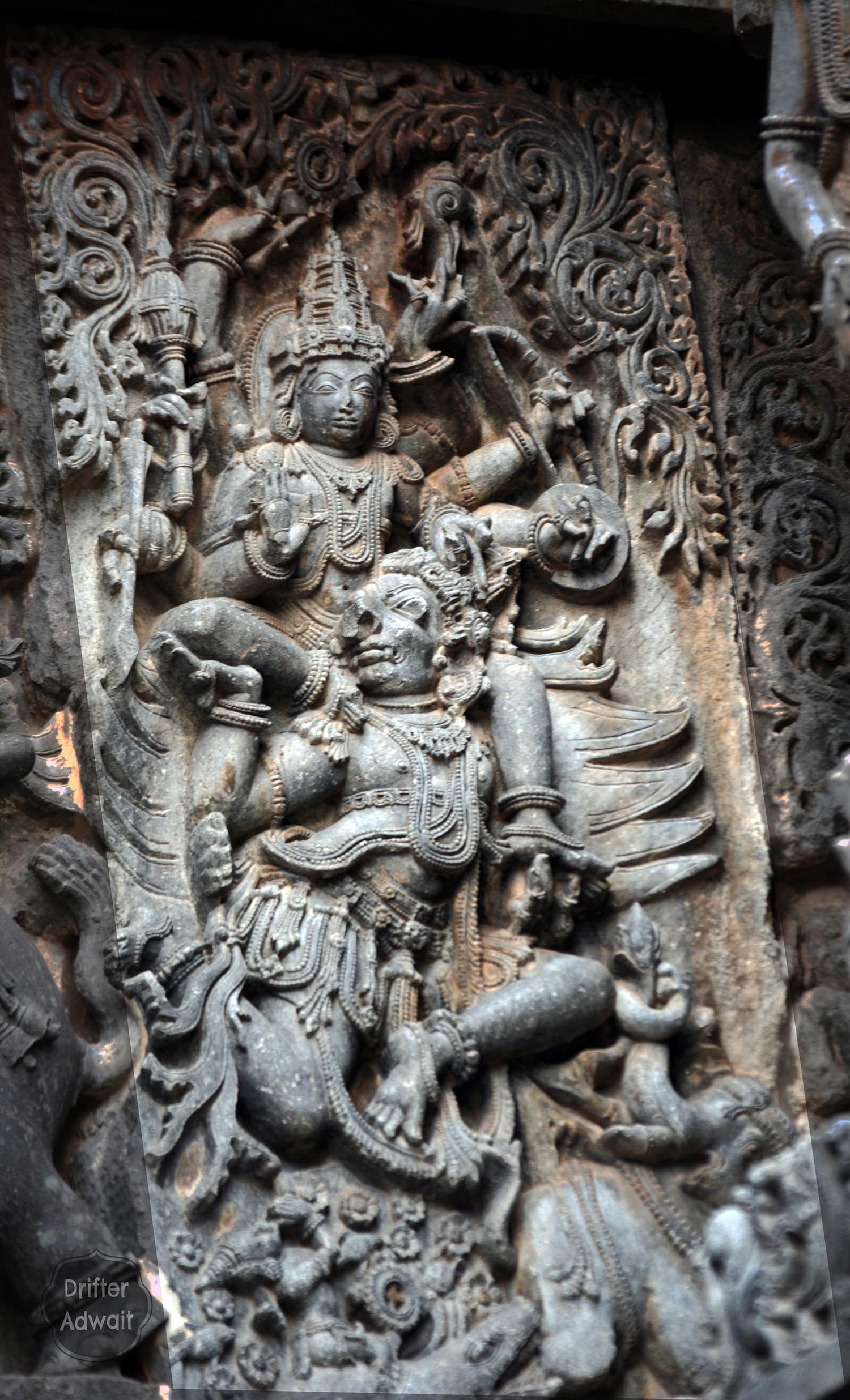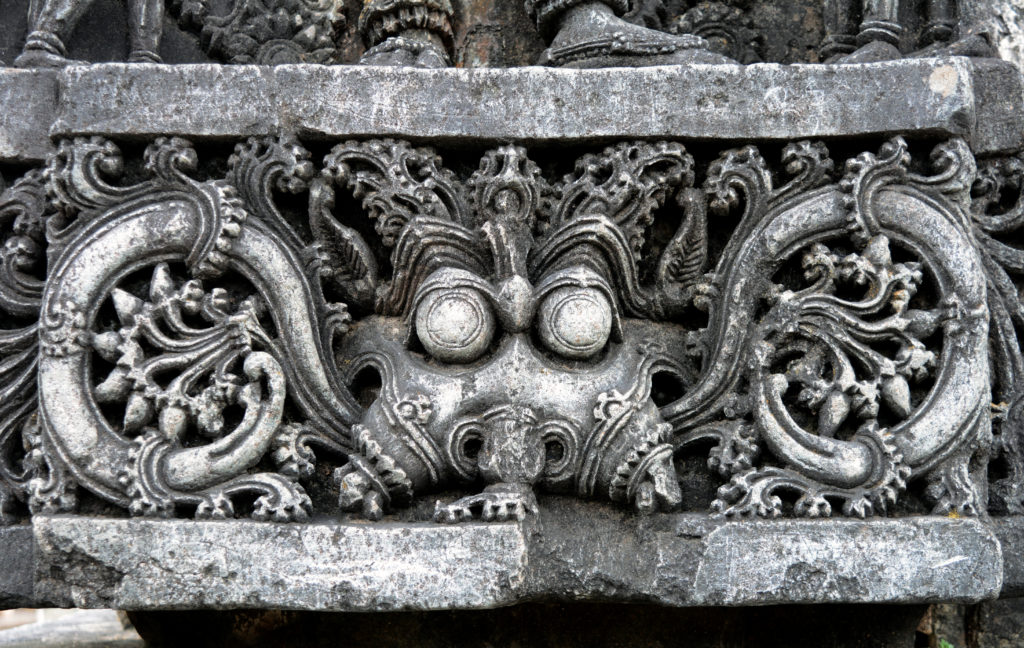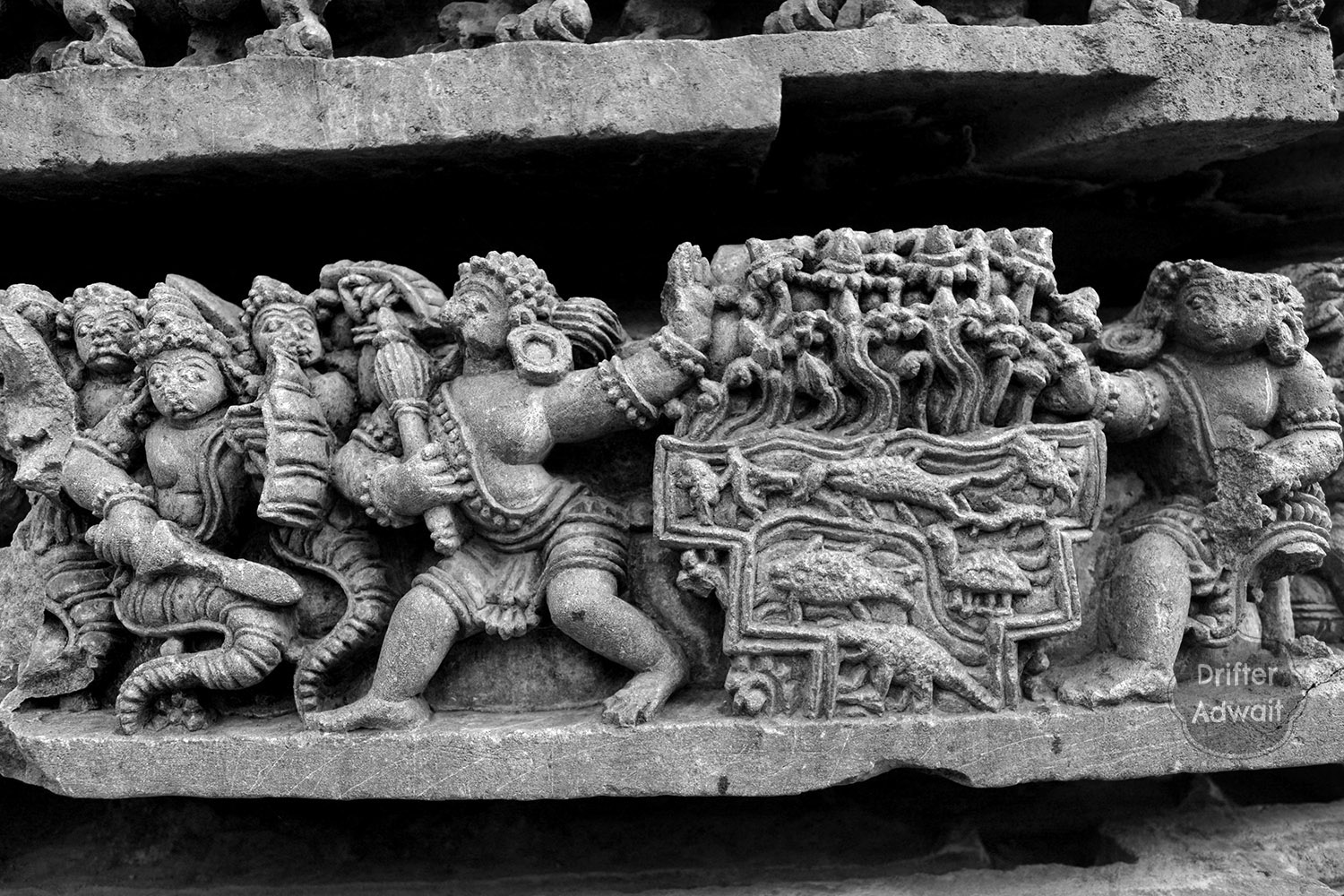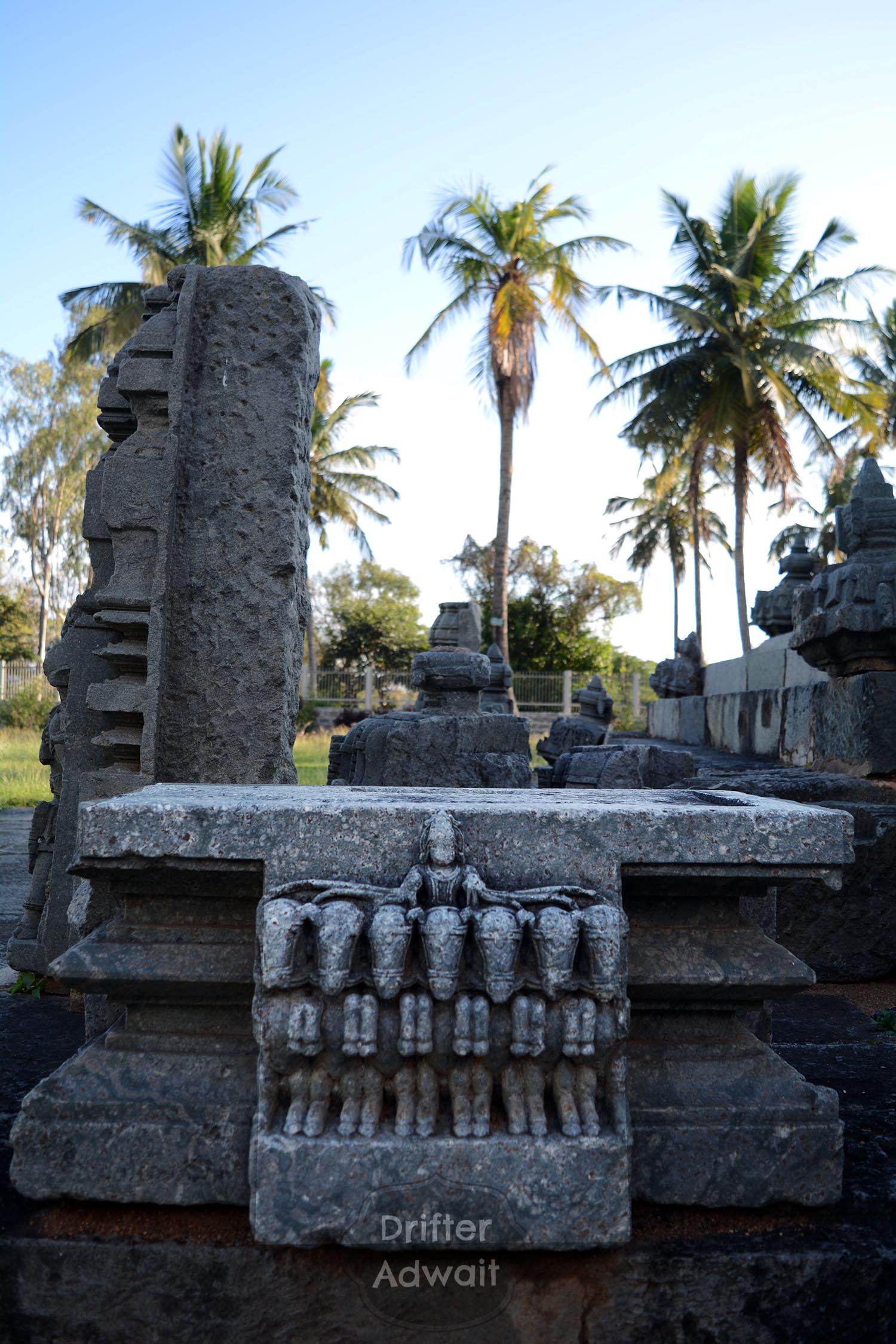GajendraMoksha is one of the most favorite topics of sculptures, sourced from the epics like Vishnu Puran and Pancharatni Geeta. Vishnu freed the elephant from the jaws of Makara or Nakra. This avatar of Vishnu is also popular as Karivad, Varadaraj, or Hari, as he gave the blessings of life to Kari (elephant). Here, Vishnu is shown with four hands; in his upper hands, he usually holds Shankha and Chakra. His lower hands are shown in Varada and Katihasta Mudra. Usually, the crocodile or Makara holds the elephant’s leg, but during Gupta time, the crocodile was depicted as a snake.
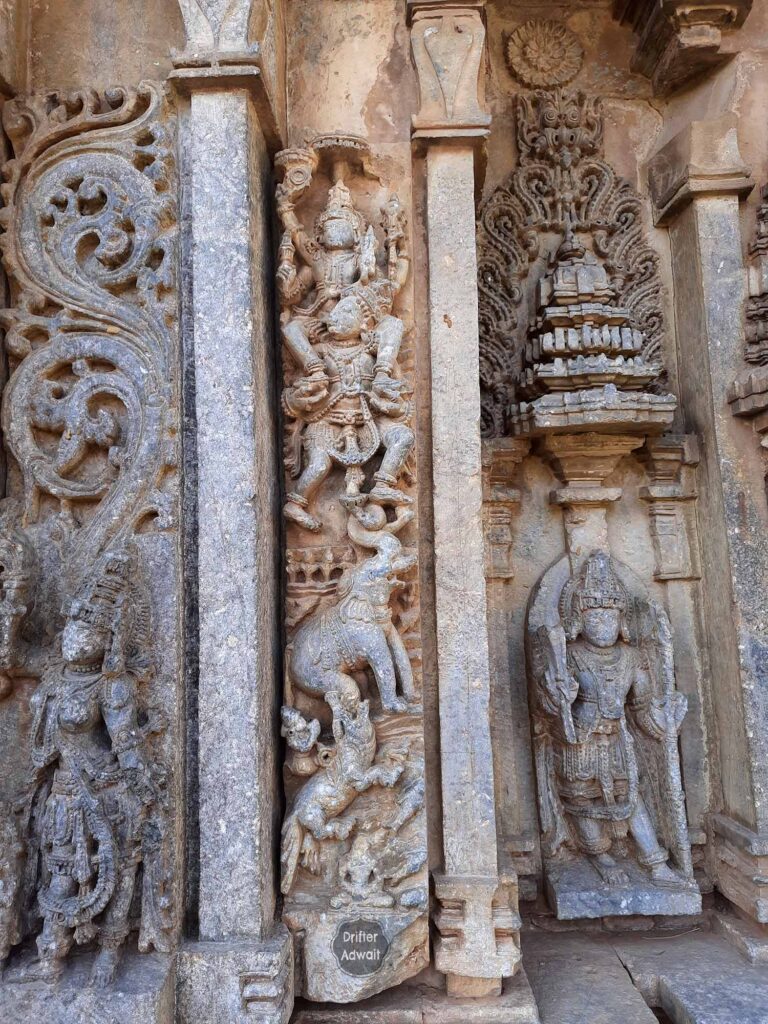
The first sculpture is from the Hoysala walls, Bucheshwara temple, located at Koravangala. In this temple, built even before 800 years, you will see a vertical sculpture panel packed with story. On the top, you will see Bhagavan Vishnu under a parasol. He holds Mace, Chakra, Lotus, and conch in his four hands while riding in the anthropomorphic Garuda. You can see the Garuda under Vishnu, supporting his lord with his two hands. Beneath the Garuda’s feet, you can see an elephant offering prayers along with the lotus to Vishnu. His hind leg is stuck in the powerful jaws of Makara. Lord Huhu is depicted riding the crocodile. You can see the underwater fishes and a Yogi meditating waters.
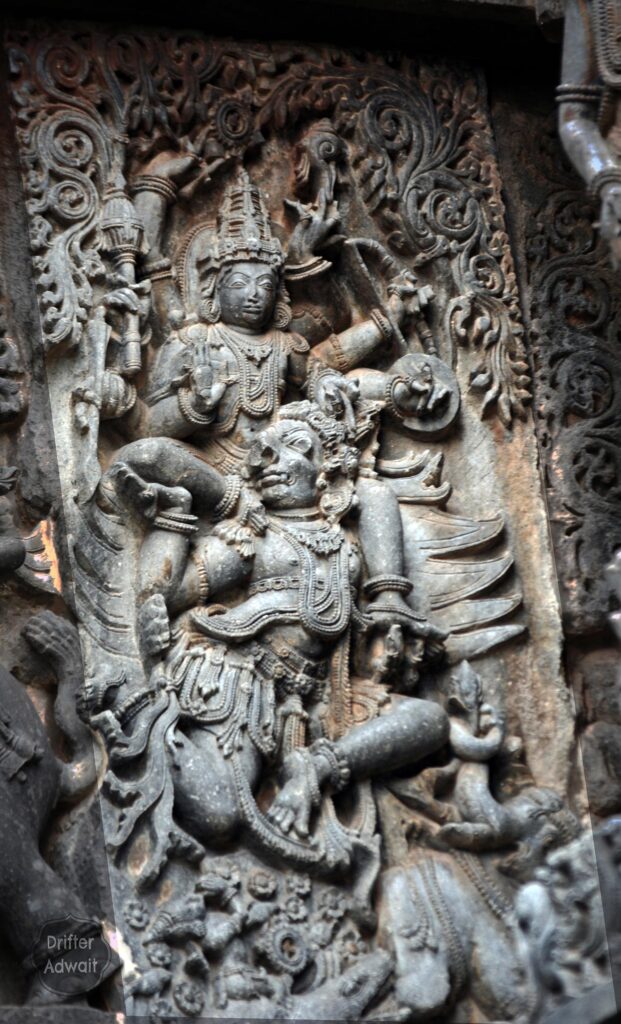
The second sculpture is from the mystic walls of Hoysaleshwar temple, Halebidu. Entrapped in the enchanting border of creepers, this is probably one of the most beautiful and detailed depictions of the GajendraMoksha. In the right hand, Shri Hari Vishnu is holding an arrow, mace, and is Sudarshan Chakra. His lowermost right hand is in Varada Mudra. On his left, Vishnu holds a flower, shield, Sharanga bow, and conch Panchajanya. He is sitting in Vama Lalitasana.
By looking at the Garuda carrying his lord, you can clearly see that the sculpture has invested his imagination and perhaps months of his time in this artwork. Garuda’s face is rather fierce, and you can feel this with his protruding teeth, pointy nose, and wide-opened eyes under his curved yet graceful eyebrows. From top to bottom, Garuda is covered with ornaments like crowns, earrings, Mala, Katibandh, Vanamala, bracelets, and anklets. You can see his flattering wings on both sides, and the way he supports his lord with his two hands is simply astonishing and reflects pride, poise, and respect for his master.
Bellow him, you can see an elephant struggling to survive. He is holding a lotus and presenting it to Vishnu. Under the right knee of Garuda, you can see the crocodile holding down the elephant in his killer jaws. Riding him, you will see the Gandharva saluting the Hari, as crocodiles and elephants are now set free from the materialistic world by a divine force.
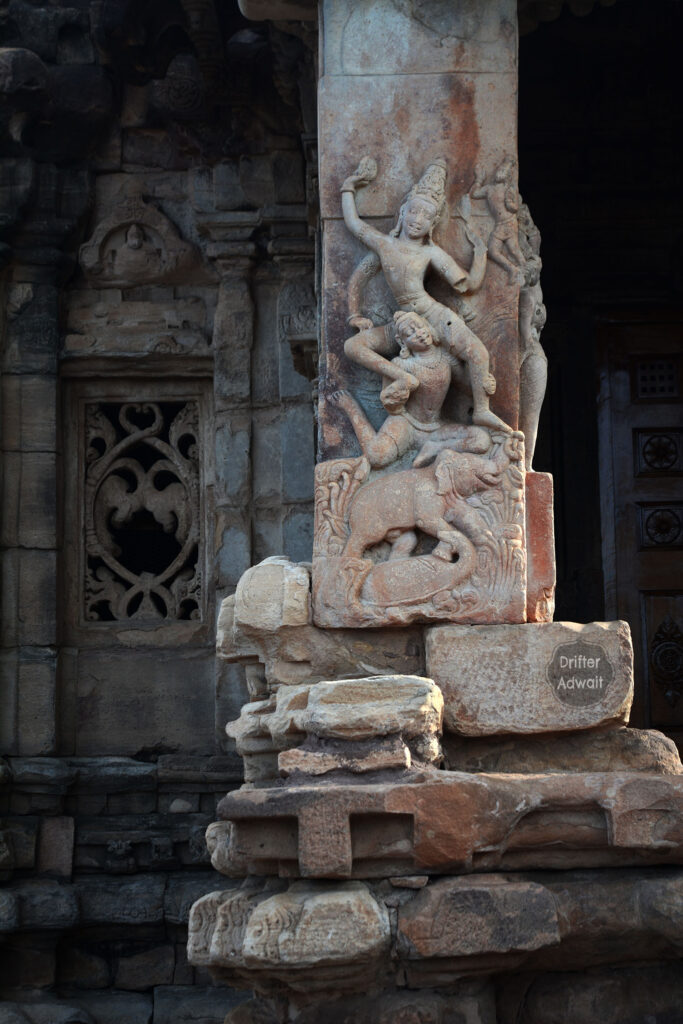
The third sculpture is from the pillar of Virupaksha Temple, Pattadakal. This sculpture is believed to be a 1282-year-old piece of art, as the temple was constructed in 740 AD. Four-handed Vishnu is carrying a disk and conch in his upper hands, and his lower hand is in Katisama Mudra. Another hand has been chopped by the vandals or perhaps by the invaders.
Floating lotuses with their thin stems are carved here rather splendidly, and they are floating on the tides created due to the fight that’s going on between the elephant and the creature holding its leg. But here, instead of the crocodile, the turtle is depicted pulling the elephant’s leg. This makes the sculpture unique and one of a kind.
Gajendra Varada Temple:
Immortalizing this incident, Cholas built a temple in Tamilnadu. This temple was built in the 8th century with Dravida-styled architecture in a small village named Thirukkavithalam near the town of Kumbhakonam. Six-day festival is conducted here in July, during which Gajendra-Leela is celebrated here. Initially built by the Chola Kings, the temple was expanded by the contribution of the Vijaynagara Kings and later by the Nayakas of Madurai.
Gajendra Varadar or Vishnu is the primary deity, reclining on the Aadi Shesha, or Bhujanga Shayanam Asana. In another sanctum sanctorum, you can see the Vigrahas of Vishnu riding on Garuda, a crocodile, and an elephant holding a flower.
Story of GajendraMoksha:
This is a story before time. There was a legendary mountain named Trikuta, located in the middle of Ksheer Sagara. Trikuta had three peaks of gold, silver, and iron, glazing proudly under the sun. The entire mountain was covered with plush vegetation and many waterfalls; beneath, the soil was rich with minerals and precious jewels. The dense jungle beneath the hill was filled with different animals, birds, trees, and creeps.
तस्य द्रोण्यां भगवतो वरुणस्य महात्मन: । उद्यानमृतुमन्नाम आक्रीडं सुरयोषिताम् ॥
(Bhagvat Puran, Canto 8, Chapter 2, Shloka 9)
Siddhas, Caraṇas, Gandharvas, Vidyadharas, serpents, Kinnaras, and Apsaras used to come here to play, dance and sing, making this mountain an absolutely heavenly place. In those jungles, there was a garden named Rutumat, belonging to God Varuna. The park had many trees that yielded flowers and fruits during all the seasons. The garden had a clear lake, crystal clear waters, densely populated with shining golden lotuses, flocks of water birds, colorful fishes, etc.
One day, from the jungle, appeared a giant elephant named Gajapati, and he dipped his strong feet in the clear lake waters. The entire elephant herd followed him to the lake and started playing with the intoxicating water of the lake. Then, this King elephant quenched his thirst with the lake’s cold, crystal-clear water, losing his fatigue. Filling his trunk with water, playful Gajapati sprayed the water all over his wives and children. And then,
तं तत्र कश्चिन्नृप दैवचोदितो ग्राहो बलीयांश्चरणे रुषाग्रहीत् । यदृच्छयैवं व्यसनं गतो गजो यथाबलं सोऽतिबलो विचक्रमे ॥
(Bhagvat Puran, Canto 8, Chapter 2, Shloka 27)
Suddenly, a strong crocodile was provoked and strangled the elephant’s leg in the water. The elephant was stronger and tried to set free from the crocodile’s jaws.
With all of his might, Gajendra tried to set himself free from the jaws of death, but the attempt was unsuccessful. This war of tug went on for thousands of years and seeing this, all the demigods simply felt amused. Due to such a prolonged fight, the elephant became weak, drained of his energy as the days passed. Contrary to that, anticipating the end, crocodiles’ energy, enthusiasm, and physical strength were on the rise.
The elephant realized that his end was near. He realized that his fellow elephant friends, relatives, and wives could not save him anymore. In helpless agony, he decided to seek shelter with divinity. In this agony, the great elephant began chanting the mantra, calling the lord.
तं तद्वदार्तमुपलभ्य जगन्निवास: स्तोत्रं निशम्य दिविजै: सह संस्तुवद्भि: ।
छन्दोमयेन गरुडेन समुह्यमान- श्चक्रायुधोऽभ्यगमदाशु यतो गजेन्द्र: ॥
सोऽन्त:सरस्युरुबलेन गृहीत आर्तो दृष्ट्वा गरुत्मति हरिं ख उपात्तचक्रम् ।
उत्क्षिप्य साम्बुजकरं गिरमाह कृच्छ्रान्नारायणाखिलगुरो भगवन् नमस्ते ॥
(Bhagvat Puran, Canto 8, Chapter 3, Shloka 31, 32)
Seeing the desperate elephant and responding to his prayers, the omnipotent Bhagvan appeared in front of him, riding a Garuda, and carrying disc, mace and many other weapons. Seeing him, even during that severe pain, Gajendra offered lotus and respectful obeisances to Hari, despite of being in this tormented condition. And then,
तं वीक्ष्य पीडितमज: सहसावतीर्य सग्राहमाशु सरस: कृपयोज्जहार ।
ग्राहाद् विपाटितमुखादरिणा गजेन्द्रं संपश्यतां हरिरमूमुचदुच्छ्रियाणाम् ॥
(Bhagvat Puran, Canto 8, Chapter 3, Shloka 33)
Seeing Gajendra in trouble, Vishnu descended from Garuda and, with his Sudarshan chakra, freed the head of the crocodile from the rest of his body while all the demigods gazed from above.
At this point, both Gajendra and the crocodile remembered what they were in the previous birth.
Indradyumna was a legendary Pandya king, a descendant of king Manu, who was an avid follower of Bhagavan Vishnu. He was a righteous king, who performed a lot of Yadnyas, carried out the donations of millions of cows, and cared for his pupil like his own progeny. Once, while he was busy performing the meditation with the vow of silence, Guru Agasti walked into his chambers. Lost in devotion, the King did not stand up and welcomed his Guru Agastya Muni.
तस्मा इमं शापमदादसाधुरयं दुरात्माकृतबुद्धिरद्य।विप्रावमन्ता विशतां तमिस्रंयथा गज: स्तब्धमति: स एव ॥
(Bhagvat Puran, Canto 8, Chaper 4, Shloka 10)
Seeing this, Agastya Muni cursed the King, saying that he was degraded and uneducated and the one who insulted Brahmins. He shall enter the kingdom of darkness with the body of the dull and dumb elephant.
To make him understand the value of humility, Agasti cursed him to be an elephant and said, Once you surrender yourself entirely to the divine, letting the ego and pride, Lord Vishnu himself will take you to salvation. King turned into an elephant and went towards the mountain Trikuta. There, he became the leader of the elephant herd and started living there peacefully, attending to his penance.
Thousand years passed, and almost everyone forgot what happened, even the name Indradyumna.
Somewhere else, there lived a Gandharva named Huhu. He was the King of his Gandharva kingdom. Once, sage Deval arrived in his kingdom. The following day when both of them were performing the Arghya puja to the sun, standing in the river, Huhu decided to pull mischief on the great sage, who was completely immersed in his morning rituals. Huhu went underwater and pulled the leg of sage, pretending to be some underwater creature. Sage Deval had no patience for such mischief and cursed the Gandharva to spend eternity as a crocodile, as he was a fan of creeping under the water and attacking his victims.
Immediately realizing the mistake, Huhu dove toward the feet of the sage, apologizing and pleading for forgiveness. After all, it was the curse, given by a righteous person, not to be taken back. Realizing King has regretted his mistake, Deval modified the curse. He said, dear King, this curse shall not last for eternity. You will stay in the lake for many eons and shall be liberated by lord Vishnu himself.
Back to the current time, when the crocodile was killed, Gandharva Huhu got his original form. He performed circumambulations around Hari, singing his praises, and with Brahma, he returned to the Gandharvaloka. And elephant, now transformed into its original form. Sitting on Garuda, Shri Hari Vishnu went to Vaikuntha, taking the King with him.
What can we learn from GajendraMoksha?
Gandharva King Huhu tried to pull mischief on a great sage, and he had to spend his next life underwater tormenting the Vishnu devotee. This explains there is a time and there is a place to make fun of people, or thather, you should never make fun of others. If done, one has to pay heavy consequences.
Lost in meditation, King Indradyumna forgot about his duties towards his guests, sage Agastya Muni. He failed to live upto the Atithi Devo Bhava tradition. As a result, he had to take birth as an elephant. Even in the form of an elephant, he continued his devotion. This underlines that even when a devotional person falls down, he is never degraded.
As the elephant struggled harder, the crocodile’s jaws tightened around his feet, dragging him to death. This explains the true nature of Maya or the illusionary world. The more you entertain it and take it too seriously, it pulls you downwards.
Just like the strong jaws of a crocodile, materialistic things constraint and divert the devotees. When the elephant sees his end, he gives up the struggle and surrenders completely to God. That’s the point when Shri Hari appears in front of the elephant to save him. In short, GajendraMoksha is the everlasting fight in the devotee’s mind, where his consciousness is torn between his devotion and materialistic world.
References:
1. Shrimad Bhagavatam, Canto 8, Chapters 2 and 3
2. Bhartiya Murtishastra, N. P. Joshi, Second Edition (1 January 2013), Prasad Prakashan, Pune, Maharashtra, India.
3. Murtividnyan, Dr. G.H. Khare, Bharat Itihas Snashodhan Mandal, Pune, Maharashtra, India.
